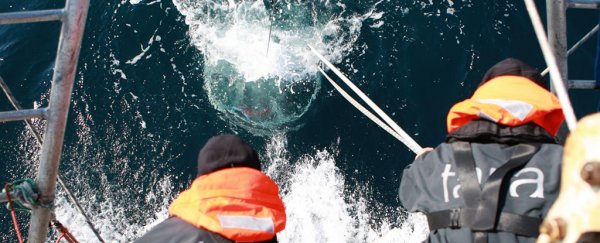The oceans hide all kinds of secrets and unknowns in the deep – like the 195,728 viruses that scientists just found lurking underwater, during the course of a pole-to-pole expedition carried out to survey marine life. The researchers say the vast majority have never been seen before.
Prior to this, we only definitively knew about 15,000 of these ocean viruses - so this study is a huge deal for our understanding of our planet.
The researchers say the findings can teach us more about everything from the evolution of life on the planet to the potential consequences of climate change.
The research is based on samples collected between 2009 and 2013 by a crew on board the Tara, a vessel that's spent more than a decade on the water investigating the science of the ocean and the clues it can give us to how our world is evolving.
 The Tara. (A. Deniaud Garcia/ Fondation Tara Ocean)
The Tara. (A. Deniaud Garcia/ Fondation Tara Ocean)
"Viruses are these tiny things that you can't even see, but because they're present in such huge numbers, they really matter," says one of the team, microbiologist Matthew Sullivan from Ohio State University.
"We've developed a distribution map that is foundational for anyone who wants to study how viruses manipulate the ecosystem. There were many things that surprised us about our findings."
Despite the large number of viruses discovered, and the vast complexity of the world's ocean regions, the team of researchers was able to split the viruses into five distinct ecological zones – all depths of the Arctic and the Antarctic, and three distinct depths of the Temperate and Tropical regions.
In fact the Arctic Ocean – where the researchers weren't expecting the most biodiversity – turned out to be an unexpected hotspot of life. It all adds to our understanding of how viruses get around the planet.
Scientists estimate there are many tens of millions of viruses in the ocean, many of which might exist out of the water as well, and even in our own bodies. Being able to identify more of them can teach us more about life itself, not just life underwater.
For the purposes of this study, as well as spotting new viruses found in water samples from depths of down to 4,000 metres (13,123 feet), the researchers also identified new strains from analysing other microbes and living creatures that have set up home in the oceans.
The comprehensiveness of the new research also matters because it helps scientists more accurately calculate the balance of oxygen and carbon dioxide in the atmosphere – marine organisms help recycle oxygen, while the oceans soak up and store a lot of CO2 as well.
More life below the surface of the water means more CO2 converted into organic carbon and biomass, stored deep in the sea – rather than CO2 acidifying the oceans, and killing off marine life along the way. It's a delicate and complex set of mechanisms.
"Having a new map of where these viruses are located can help us understand this ocean carbon 'pump' and, more broadly, biogeochemistry that impacts the planet," says Sullivan.
"Previous ocean ecosystem models have commonly ignored microbes, and rarely included viruses, but we now know they are a vital component to include."
The research has been published in Cell.
